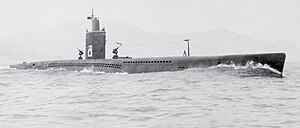I-201-class submarine

Sentaka I-202 at high surface speed
|
|
| Class overview | |
|---|---|
| Builders: | Kure Navy Yard |
| Operators: |
|
| Preceded by: | I-400-class submarine |
| Subclasses: |
|
| Built: | 1945 |
| In service: | 1945 |
| In commission: | 1945 |
| Planned: | 23 |
| Completed: | 3 |
| Scrapped: | 3 |
| General characteristics | |
| Type: | Submarine |
| Displacement: |
|
| Length: |
|
| Beam: |
|
| Height: | 7 m (23 ft) (keel to main deck) |
| Propulsion: |
|
| Speed: |
|
| Range: | |
| Test depth: | 110 m (360 ft) |
| Complement: |
|
| Armament: |
|
The I-201-class submarines (伊二百一型潜水艦 I-ni-hyaku-ichi-gata sensuikan) were submarines of the Imperial Japanese Navy during World War II. These submarines were of advanced design, built for high underwater speed, and were known as Sentaka-Dai type submarine (潜高大型潜水艦 Sen-Taka-Dai-gata sensuikan, "Submarine High speed-Large type") or Sentaka type submarine (潜高型潜水艦 Sen-Taka-gata sensuikan, "Submarine High speed type"). The type name, was shortened to Suichū Kōsoku Sensuikan Ō-gata (水中高速潜水艦大型 Underwater High speed Submarine Large type).
They were one of the fastest submarine class built during World War II, second only to Walter Type XVII closed-cycle powered submarines. Twenty-three units were ordered from the Kure Navy Yard under the 1943 construction program. Due to the deteriorating war situation, only eight boats were laid down, and only three, numbered I-201, I-202 and I-203, were completed before the end of the war. None of them saw operational use.
In 1938 the Imperial Japanese Navy constructed an experimental high-speed submarine for evaluation purposes, which was designated Vessel Number 71 (第71号艦) for security purposes. Based on previous experience with high-speed, short-range midget submarines, Number 71 displaced only 230 tons surfaced with a length of 140 ft (43 m). She could attain a submerged speed of over 21 kn (39 km/h; 24 mph), making her the fastest submarine of her day. The results gained from experiments with Number 71 formed the basis for the I-201 class submarines.
By late 1942 it had become apparent to the IJN that conventional submarines were unable to survive the new ASW techniques coming into service, such as radar, HF/DF, sonar, and new depth charge projectors. New submarines were required, with a higher underwater than surface speed, quick-diving capability, quiet underwater running, and a high underwater operational radius.
...
Wikipedia
